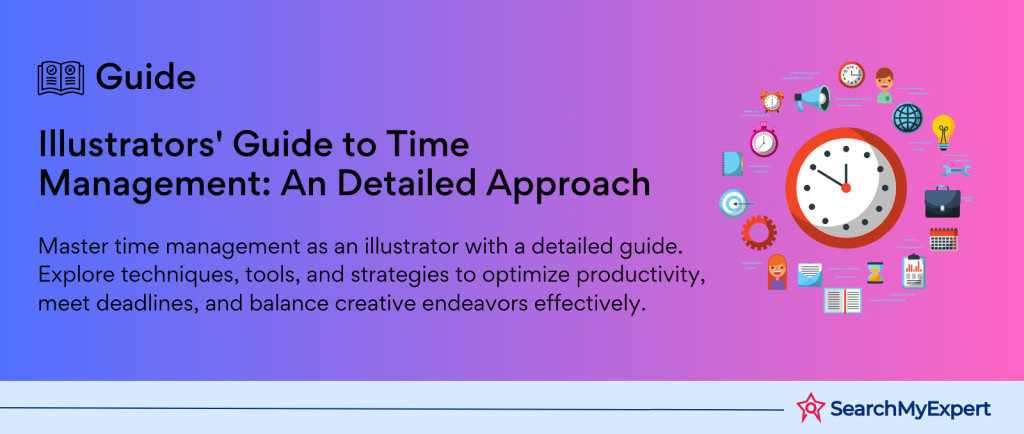Time Management Tips for Illustrators
Understanding the Unique Challenges Illustrators Face
In the world of illustration, artists often grapple with a unique set of challenges. The creative process is not linear – it’s a whirlwind of ideas, revisions, and last-minute changes. This can lead to what we call ‘creative chaos’. Let’s dive in!
- Idea Overload: Illustrators are idea factories, constantly generating new concepts. However, this can lead to an overwhelming backlog of projects.
- Client Demands: Working with a variety of clients means adapting to different styles, deadlines, and feedback loops.
- Artistic Perfectionism: Striving for perfection in each piece can eat into valuable time and hinder productivity.
Breaking Down the Artist’s Workflow into Manageable Tasks
To navigate the chaos, breaking down the workflow is crucial. Here’s how:
- Initial Conceptualization:
Start by jotting down rough ideas. Don’t get stuck on details yet. - Drafting and Sketching: Develop these ideas into more concrete sketches.
- Feedback and Revisions: Incorporate client or peer feedback early to avoid major changes later.
- Final Artwork:
Complete the piece with attention to detail, keeping the deadline in mind.
Recognizing the Enemy: Procrastination, Distractions, and Perfectionism
The biggest hurdles in time management for illustrators are often internal:
- Procrastination: Putting off tasks can lead to a snowball effect, especially with tight deadlines.
- Distractions:
Social media, a cluttered workspace, or even personal life can interrupt the creative flow. - Perfectionism:
While quality is key, over-focusing on perfection can lead to missed deadlines and burnout.
Chart Your Course: Goal Setting and Planning
Setting SMART Goals for Your Artistic Endeavors
SMART goals are Specific, Measurable, Achievable, Relevant, and Time-bound. They transform vague aspirations into achievable targets. For illustrators, this could mean setting a goal to complete a certain number of illustrations per month or mastering a new digital tool within a specific timeframe.
Prioritizing Tasks and Projects Based on Deadline and Importance
- Urgent vs. Important:
Distinguish between tasks that need immediate attention and those that are important for long-term goals. - High-Impact Tasks: Focus on tasks that significantly impact your career or project completion.
- Deadlines:
Always prioritize tasks based on impending deadlines to avoid last-minute rushes.
Creating a Realistic Weekly or Monthly Schedule
- Allocate Time Blocks: Designate specific hours or days for particular tasks, such as sketching, digital rendering, or client meetings.
- Flexibility: Allow for some flexibility to cater to creative surges or unexpected revisions.
- Balance:
Ensure there’s a healthy balance between work and personal life to avoid burnout.
Using Tools Like Calendars, Planners, and Time Tracking Apps
- Calendars and Planners: These help in visualizing your schedule, keeping track of deadlines, and planning ahead.
- Time Tracking Apps:
Apps like Toggl or Harvest can help you understand how much time you’re spending on different tasks, aiding in better time management. - Digital Reminders:
Use reminders for deadlines, meetings, and breaks to stay on track.
Taming the Time Demons: Mastering Focus and Flow
Identifying and Eliminating Distractions
- Know Your Distractions: Recognize what specifically diverts your attention – be it social media, phone notifications, or a noisy environment.
- Elimination Strategies:
Use apps to block distracting websites, turn off notifications, or create a quiet workspace.
Crafting Dedicated “Art Times” and Sticking to Them
- Consistent Schedule:
Set aside specific hours each day exclusively for artwork. - Non-Negotiable Time: Treat this time as a fixed appointment, non-negotiable and integral to your daily routine.
- Inform Others:
Make sure friends and family are aware of these dedicated art times to minimize interruptions.
Batching Similar Tasks for Enhanced Efficiency
- Task Grouping:
Group similar tasks, like sketching, emailing clients, or digital editing, and do them in dedicated blocks. - Reduced Context Switching: This approach minimizes the time lost in switching between different types of tasks.
- Streamlined Workflow: Batching leads to a more streamlined and efficient workflow.
Utilizing the Pomodoro Technique for Focused Work Intervals
- 25-Minute Focus:
Work for 25 minutes straight, then take a 5-minute break (one Pomodoro). - Regular Breaks:
These breaks help maintain high levels of focus without leading to burnout. - Task Completion: Use each Pomodoro to work on a specific task or part of a project.
Fueling Your Creativity
Scheduling Breaks and Rest Periods to Avoid Burnout
- Regular Breaks: Schedule short breaks throughout your workday to rest your mind and eyes.
- Longer Rest Periods: Allocate days off or longer periods for recuperation, especially after intense projects.
- Listen to Your Body:
Pay attention to signs of fatigue and take a break before reaching the point of burnout.
Maintaining a Healthy Sleep Schedule and Exercise Routine
- Consistent Sleep Patterns:
Ensure you get enough sleep each night to maintain optimal cognitive function and creativity. - Physical Activity: Regular exercise can improve mood, energy levels, and overall well-being, positively impacting creativity.
Engaging in Activities that Spark Inspiration and Recharge Your Creative Energy
- Hobbies and Interests:
Pursue hobbies or activities outside of illustration to stimulate your mind and creativity. - Nature and Exploration: Spending time in nature or exploring new environments can provide fresh inspiration.
- Cultural Experiences:
Visit galleries, attend workshops, or engage in cultural activities to ignite creative ideas.
Connecting with Other Artists for Support and Motivation
- Artist Communities:
Join online forums or local artist groups to connect with peers. - Collaborations:
Collaborate with other artists on projects to gain new perspectives and ideas. - Mentorship: Seek out mentors or offer mentorship to others to foster a supportive creative environment.
Tools of the Trade: Leveraging Technology for Time Management
Exploring Project Management Tools for Organizing Tasks and Deadlines
- Key Tools:
Discover tools like Trello, Asana, or Notion, tailored for task and deadline organization. - Visual Organization:
These apps offer boards and lists for a clear overview of projects. - Enhanced Collaboration: They are great for team communication and project tracking.
Utilizing Time Tracking Apps to Analyze Your Productivity Patterns
- Track Time:
Use apps like Toggl or Harvest to monitor time spent on tasks. - Productivity Insights: These apps offer insights into your most productive hours and time-consuming tasks.
- Billing Simplified:
For freelancers, these tools are essential for accurate client billing.
Investing in Noise-Canceling Headphones or Productivity Music Playlists
- Distraction-Free Zone: Noise-canceling headphones help create a focused work environment.
- Music for Focus: Playlists designed for concentration can enhance productivity.
Setting Up Email Filters and Auto-Responders to Minimize Interruptions
- Efficient Email Management: Use filters and folders to prioritize important emails.
- Auto-Responders: They inform people of your availability and reduce the need for immediate responses.
Embrace Flexibility and Adapt
Understanding that Unforeseen Circumstances and Creative Blocks Happen
- Accepting Uncertainty:
Recognize that not everything goes as planned, and unexpected events can disrupt your schedule. - Creative Blocks:
Understand that creative blocks are a normal part of the artistic process and require time to overcome.
Building Buffer Time into Your Schedule for Adjustments
- Allow for Flexibility:
Incorporate extra time in your schedule to accommodate unforeseen changes or delays. - Realistic Deadlines:
Set deadlines that give you leeway to deal with unexpected issues without stress.
Learning to Say No to Projects that Overload Your Workload
- Assessing Capacity:
Be honest with yourself about how much work you can handle without compromising quality. - Setting Boundaries: Politely declining projects that exceed your capacity is crucial for maintaining a sustainable workload.
Continuously Evaluating and Refining Your Time Management System
- Regular Reviews:
Periodically assess your time management strategies to identify what’s working and what isn’t. - Adapting Strategies: Be open to adjusting your methods and trying new techniques to improve efficiency and productivity.
Celebrate Your Progress and Enjoy the Journey
Tracking Your Achievements and Acknowledging Your Growth as an Artist
- Record Milestones:
Keep a log of completed projects and milestones to visualize your progress. - Reflect on Growth:
Regularly review your work to appreciate how your skills have evolved.
Rewarding Yourself for Reaching Milestones and Completing Projects
- Set Rewards: Plan small rewards for completing tasks or projects, like a special treat or a break.
- Celebrate Successes: Take time to celebrate the completion of significant projects or milestones.
Maintaining a Positive Mindset and Focusing on the Joy of Creating Art
- Enjoy the Process:
Remember why you love creating art and focus on the pleasure it brings. - Stay Positive: Cultivate a positive mindset about your work and creative journey.
- Balance Work and Play: Ensure a healthy balance between work and leisure to maintain enthusiasm and creativity.
Conclusion
In the vibrant and demanding world of illustration, mastering time management is not just about ticking off tasks—it’s about crafting a sustainable, fulfilling creative life. From conquering creative chaos to leveraging technology, and from embracing flexibility to celebrating progress, each step offers a valuable piece of the puzzle in managing time effectively.
Illustrators must navigate through unique challenges, balance multiple projects, and keep their creative fires burning, all while meeting deadlines and client expectations. The journey is not always straightforward, but with the right strategies in place, it can be incredibly rewarding.
Remember, time management in illustration is more than just a skill—it’s an ongoing practice that evolves with your artistic journey. By adopting these techniques, you can create a harmonious balance between work and life, ensuring that each stroke of your pen or brush contributes not just to a great piece of art, but to a great life as an artist.
Unleash creativity with top-tier Illustrators Agencies.
Table of Contents
Toggle






